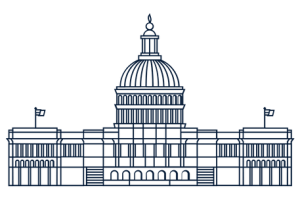What a year it has been so far! The last time I wrote you the world was a very different place. Most of your offices moved to remote work for the first time, and we have all had to adjust to this constantly changing situation. None of it has been ideal, but we have heard many fantastic stories at NAGDCA of how our members have adapted and thrived, while continuing to provide outstanding service to your participants.
NAGDCA is changing as well, but amid this change we will continue to be an indispensable resource to all of you. As you probably know by now, for the first time in our history we made the difficult decision to cancel our Annual Conference. We did this with you in mind, as your health and safety are absolutely our top priority. We simply were not willing to put any of you at risk. The Conference is a time for all of us to get together, share stories, learn from each other, and make new connections. We will all miss it greatly.
However, our inability to meet in person does not reduce the need for our members to gather and learn from each other. If anything, the need for information, ideas, and best practices has never been greater. As online technology has improved, NAGDCA can now meet this need online, not only in October but throughout the year. With that in mind, we are launching a new program called NAGDCA Connect.
Connect will combine live information from the nation’s leading public retirement experts with small group discussions and moderated topical conversations. We will use the new format to connect you to your peers and service providers, provide you with the newest research and ideas, and help you understand the latest changes to the federal legislative and regulatory environment.
These new connections will be supported by data and research from our fast-growing partnership with EBRI – called the Public Retirement Research Lab (PRRL). Over 100 governments have signed up to participate in the PRRL, creating a new resource for research and benchmarking that has never been available for public sector defined contribution plans. We are excited to see it all come together!
At NAGDCA, our goal is to continue to provide you with the information and connections you need – now more than ever. We would love to hear from you as we build for the future, so please reach out with your thoughts and ideas. Stay healthy and safe, and we can’t wait to see you in the fall.
Sandy Blair, NAGDCA President
Director, Retirement Readiness
California State Teachers’ Retirement System
Laying the Groundwork for Retirement Security Improvements in a Pandemic Summer

House and Senate leaders are currently negotiating the details of another package of legislation to bring relief to a nation still buffeted by the ongoing COVID-19 public health emergency and the economic crisis that that the pandemic has provoked. NAGDCA members’ plan participants are on the front lines of providing essential public services during this time and have a lot at stake in the outcome of these debates. And at the same time, NAGDCA continues to look for opportunities to advance the legislative proposals that will improve retirement outcomes for them now and into the future.
State and local government fiscal relief is proving to be one of the major points of contention between the sides. Democrats support a provision from the Heroes Act passed by the House back in May, which would give about $500 billion to states and about $500 in direct, flexible funding divided between cities and counties. The Senate Republican leadership, supported by the Trump Administration, have introduced the HEALS Act, a collection of bills, rather than one comprehensive bill. This package contains no new money for state and local fiscal relief but would amend the permissible uses of the CARES Act fund for states and locals to allow up to 25 percent to be used to backfill lost revenues. States or local governments taking this option would be barred from using the fund for pensions or other post-employment benefits. They would also be required to share 25 percent of their funding with smaller “downstream” jurisdictions. Other sticking points include the structure of enhanced unemployment insurance and Senate Majority Leader McConnell’s insistence on liability shield provisions for businesses.
It is worth noting that the Senate Republicans’ HEALS Act package does include some revisions/clarifications proposed by the Finance Committee to the retirement provisions of the CARES Act relevant to D.C. plans.
- The HEALS Act clarifies that money purchase plans are included in the retirement plans qualifying for the temporary rules permitting individuals to make penalty-free withdrawals from certain retirement plans for coronavirus-related expenses, and permitting taxpayers to pay the associated tax over three years, recontribute withdrawn funds and increases the allowed limits on retirement plan loans. The provision applies retroactively.
- The HEALS Act also clarifies that plans may rely on an employee’s self-certification that the employee meets the requirements for the increased limits on retirement plan loans. The provision applies retroactively.
With the scheduled August Recess looming, it is unclear if an agreement will be reached or how big it will be and what it will include.
Meanwhile NAGDCA continues to lay the groundwork for progress on its legislative priorities. Over the past few months, the House Ways and Means Committee has been working to develop a new bi-partisan package of retirement legislation that could be introduced in the Fall. After a number of conversations with Committee staff we have reason to be optimistic that some of our priorities may be included in this bipartisan Ways and Means SECURE 2.0 package. It would be our hope that this could then advance with a bi-partisan Senate package built around S. 1431, the Retirement Security and Savings Act introduced by Senators Rob Portman (R-Ohio) and Ben Cardin (D-Md.), which includes all of NAGDCA’s affirmative legislative priorities.
If you are interested in getting involved in developing and advocating for NAGDCA’s federal policy agenda, consider applying to serve on the Legislative Committee.
 Paul Beddoe
Paul BeddoeConsiderations for Employer Retirement Plan Contributions during Coronavirus
by Troy Jensen, QKA, APA | Vice President | Innovest Portfolio Solutions
Ongoing economic and market conditions are hitting both employers and employees hard, taking a heavy toll on available finances. While hopeful signs of recovery are starting to appear, there remains a good deal of uncertainty as to both the timing and pace of renewed economic growth. In the meantime, many retirement plan sponsors must regrettably consider making adjustments to employer plan contributions.
Whether temporary or longer-term, contribution changes should be carefully evaluated, weighing both existing regulatory and statutory requirements, the CARES Act, and other relief measures. Retirement plans are subject to a variety of stringent rules, depending on the type of plan and the associated Federal, state, and local laws and provisions in play. No matter the employer or plan type, there are important considerations for plan sponsors to keep in mind as they consider changes to contribution levels – or discontinuing them entirely for a time. Particularly for public plans, local, state, or Federal law may require contributions, further limiting the options.
Reductions also have a very direct effect on the retirement savings rate of employees, particularly at a time when many may already be experiencing coronavirus-related medical costs, loss of income, or related economic stress. While changes may be necessary or pragmatic, they also carry certain longer-term costs in employee dissatisfaction and regard for the employer. Ill will created amongst plan participants may diminish the value of direct contribution savings and hurt retention of talented employees down the road.
“Fixed” vs. “Discretionary”
Defined contribution retirement plan documents generally provide for employer contributions in either a fixed or discretionary formula. Discretionary provisions allow for inherent flexibility in adjusting the contribution formula without any need to amend the plan document and without a requirement to notify affected employees in advance (though proactive notification is still strongly recommended). This discretionary approach allows the contribution to be reduced or eliminated quickly, providing quicker results for employers facing budget shortfalls.
Fixed contributions, by contrast, are specifically defined within plan language, requiring the employer to enact a plan amendment – or even enact a change in code/law – before implementing the adjustment. A careful review of your plan document and/or any governing statutes is necessary to determine which type of contributions are in place and whether they can legally be amended. Keep in mind that many plan providers charge a fee for executing an amendment to a plan, and there is also likely a significant timeframe involved to carry out the amendment and notify employees in advance of the change.
Note also that a match or non-elective contribution formula commonly might have been consistently applied, even for many years, but that does not automatically mean it is based on a fixed formula. The underlying provisions might still allow for discretionary application. Collectively bargained and similarly negotiated benefits or promises to employees are also part of any evaluation. As costly legal challenges can result if not resolved ahead of any change, consulting your ERISA or benefits counsel before taking action is highly encouraged.
For plans that have enacted them, Safe Harbor contribution provisions have further unique limitations. Safe Harbor contributions typically cannot be discontinued mid-plan year unless the employer can qualify for certain exceptions. In the current economy, demonstrating an immediate status of operating at an economic loss would qualify. Nonetheless, bear in mind that it would still generally require at least 30 days’ advance notice to employees before ending contributions. Safe Harbor “wait-and-see” provisions, allowing the employer to end or not make contributions for any given plan year, are less common, but are built to allow greater flexibility. The arrangement must have been in place ahead of the plan year to be available, however, so it cannot be added retroactively.
The Setting Every Community Up for Retirement Enhancement (SECURE) Act, passed by Congress late in 2019, provided additional options for suspending or reducing certain contributions. Employers utilizing a non-elective (or profit sharing) Safe Harbor formula were granted additional flexibility in suspending contributions and sending the related notice requirements. Since these provisions are new for 2020 plan years and beyond, we anticipate further guidance from the Department of Labor and IRS. Obtaining advice from qualified counsel can help navigate the availability (or not) to your plan.
Missed or Delayed Contributions and Nondiscrimination Testing
Whether facing immediate or anticipated budget shortfalls, remember that existing rules for timely remittance of contributions to the plan’s trust are still in place. It may be tempting to delay or postpone funding contributions in favor of other obligations and expenses, but that approach can carry significant penalties up to and including tax disqualification of the plan if not maintained. Continue to appropriately send employee and employer payroll contributions, including loan payments, on the same schedule as typical. Not doing so can easily cost dramatically more in the long run.
Employer contribution changes may also affect nondiscrimination testing compliance for the plan year. Your plan’s recordkeeper or third-party administrator can help evaluate any proposed changes that may affect your compliance testing status.
Freezing or Terminating
A more extreme consideration might be discontinuing the plan altogether. While outside the scope of this overview, it is worth noting that plan termination or freezing carries specific notice and regulatory requirements that are both complex and costly if not appropriately met. We highly recommend engaging your qualified plan counsel to help evaluate your circumstances if these options are being considered.
The ongoing COVID-19 pandemic and related shutdowns continue to test employers and individuals, and it is reasonable to expect more uncertainty in the months to come. At the same time, challenging markets provide ample opportunity for retirement savers and plan sponsors with a long-term focus to not only endure, but to enhance their position in the long run. Keeping a “big picture” focus can provide needed context to this and any economic climate.
Author Bio
Troy is a Vice President and Consultant at Innovest Portfolio Solutions. He focuses primarily on guiding retirement plan sponsors and institutional investors in execution of their fiduciary, compliance and operational responsibilities. He is part of Innovest’s Retirement Plan Practice Group, a specialized team that identifies best practices and implements process improvements to maximize efficiencies for retirement plan clients. Troy has earned a Qualified 401(k) Administrator (QKA) credential from the American Society of Pension Professionals and Actuaries (ASPPA) and an Accredited Pension Administrator (APA) designation from the National Institute of Pension Administrators (NIPA).
About Innovest
Innovest is a trailblazing, independent, mission-driven investment advisory firm with offices in Colorado, California and Arizona. Innovest’s mantra is Making Retirement Work. Innovest achieves this by improving retirement outcomes for employees and reducing fiduciary risk for employers. We execute this with uncommon service. Learn more at www.innovestinc.com.
Click here to download the article.
NAGDCA CONNECT REGISTRATION OPEN
Registration is now open for NAGDCA’s new virtual event, NAGDCA Connect – Virtual Engagement and Learning Series. The online interactive learning series launching in October will feature a variety of topical sessions and small group discussions to provide a new virtual opportunity to learn and network with your peers.
Now more than ever, it’s important to connect and learn from one another, and we’re excited about the new opportunities a virtual space provides. NAGDCA Connect is open to everyone and we encourage you to invite colleagues outside of the NAGDCA community to attend. More information about sessions and speakers is coming soon! Keep an eye on the event page on our website for the latest information.
Click here to register today!
2020 LEADERSHIP AWARD WINNERS
Congratulations to our 2020 Leadership Award winners! NAGDCA’s annual awards program recognizes excellence and innovation in retirement plan design, participant education, technology, and/or effective communication methods in government defined contribution plans.
Projects and campaigns from NAGDCA government members were eligible for nomination. NAGDCA’s Awards Committee served as judges to review nominations across the National Retirement Security Week; Participant Education and Communication; Plan Design and Administration; and Technology and Social Media categories.
We encourage you to click here to learn more about your peers’ innovative, award-winning projects and campaigns!
2021 VOLUNTEER OPPORTUNITIES
Looking to get more involved with NAGDCA? Committee sign ups will open in late August and we encourage all those that are interested in participating to submit their name. We will also open various ad hoc volunteer opportunities throughout the next year so keep an eye on your inbox for those opportunities.
SAVE THE DATE – NRSM OCTOBER 2020
NRSM is an opportunity to increase awareness and educate employees about the importance of saving for retirement by investing in an employer-sponsored defined contribution plan. Now is the time to start strategizing and planning for how your plan will promote the week. Click here to visit the NRSM web page for a suggested timeline to help with planning leading up to October.

